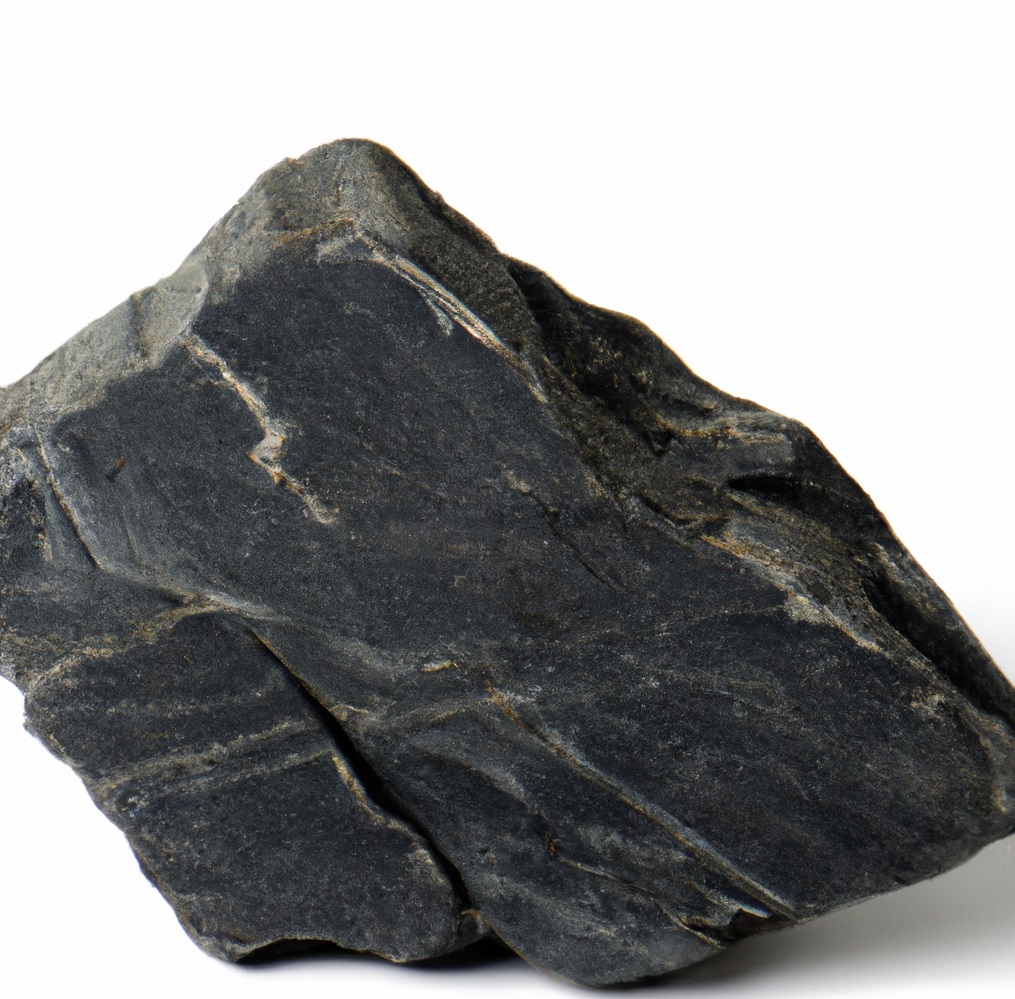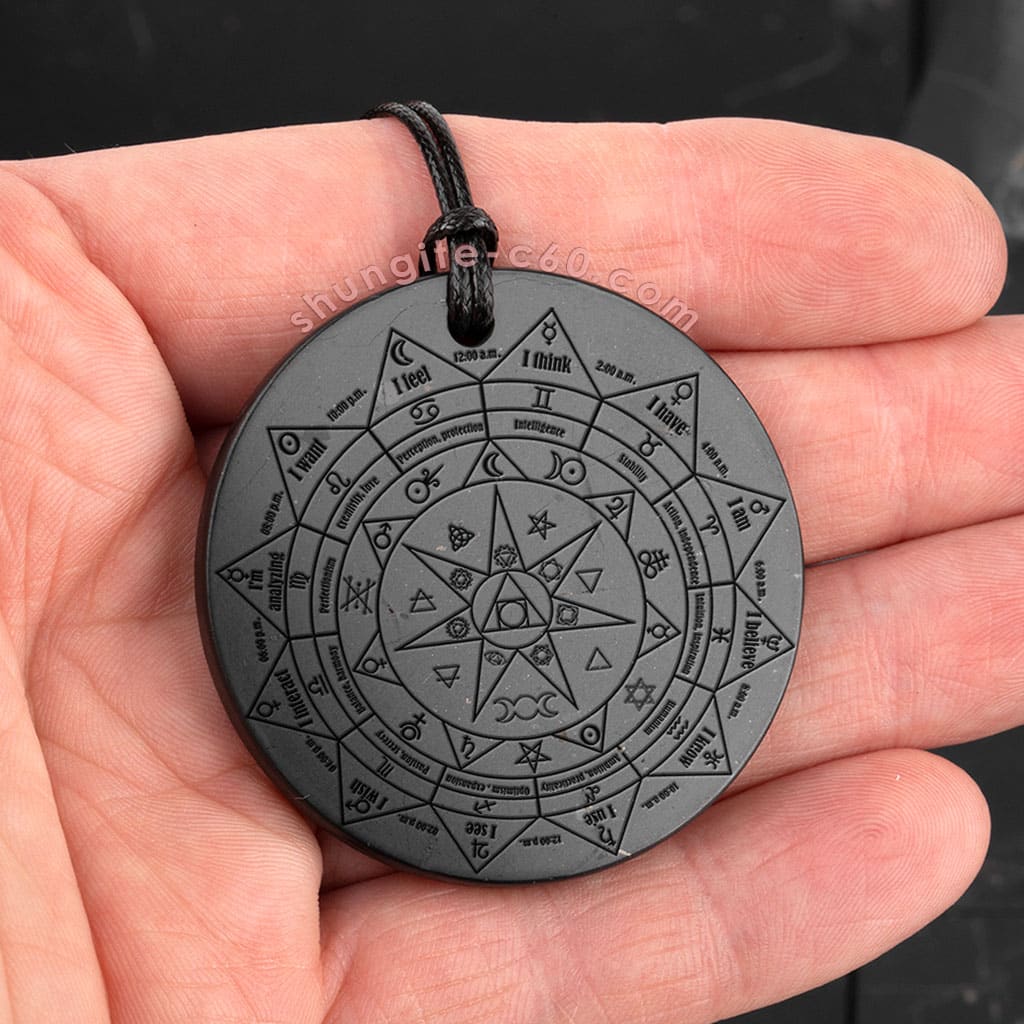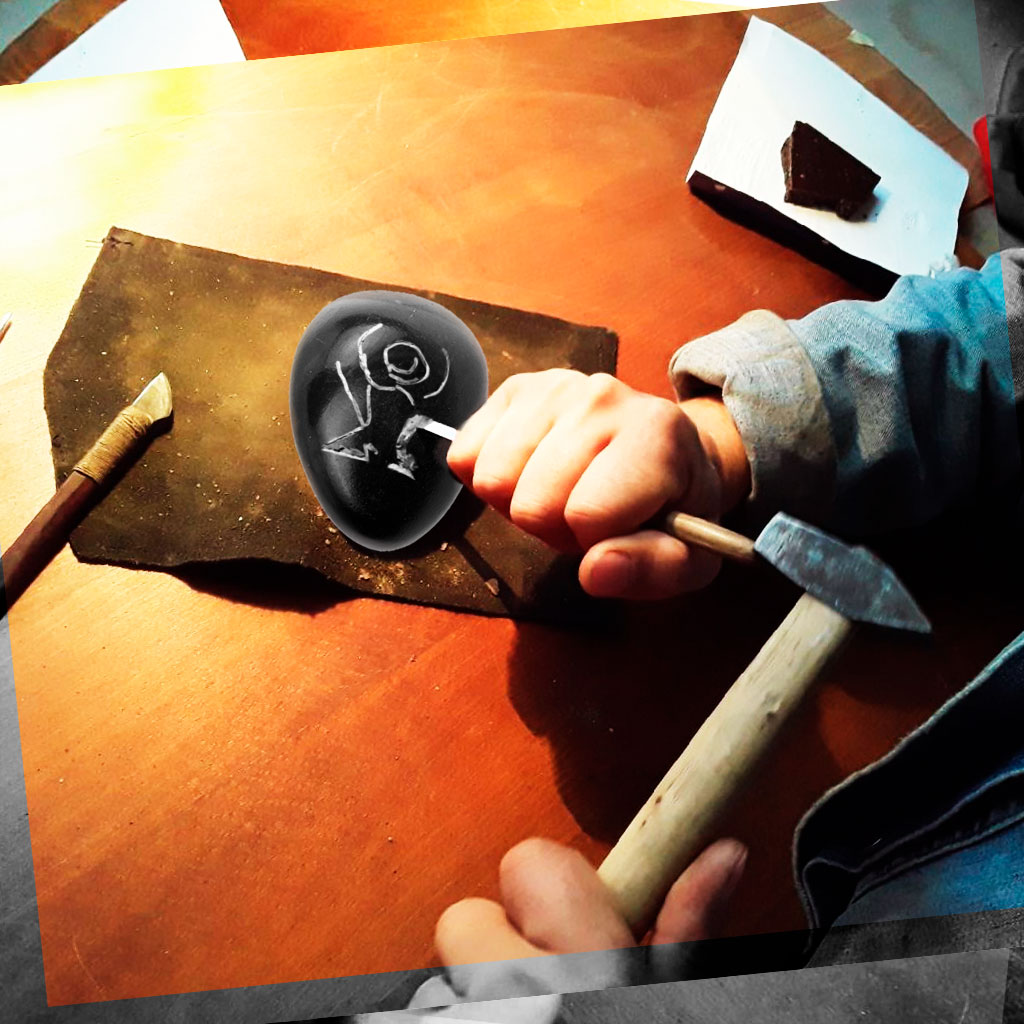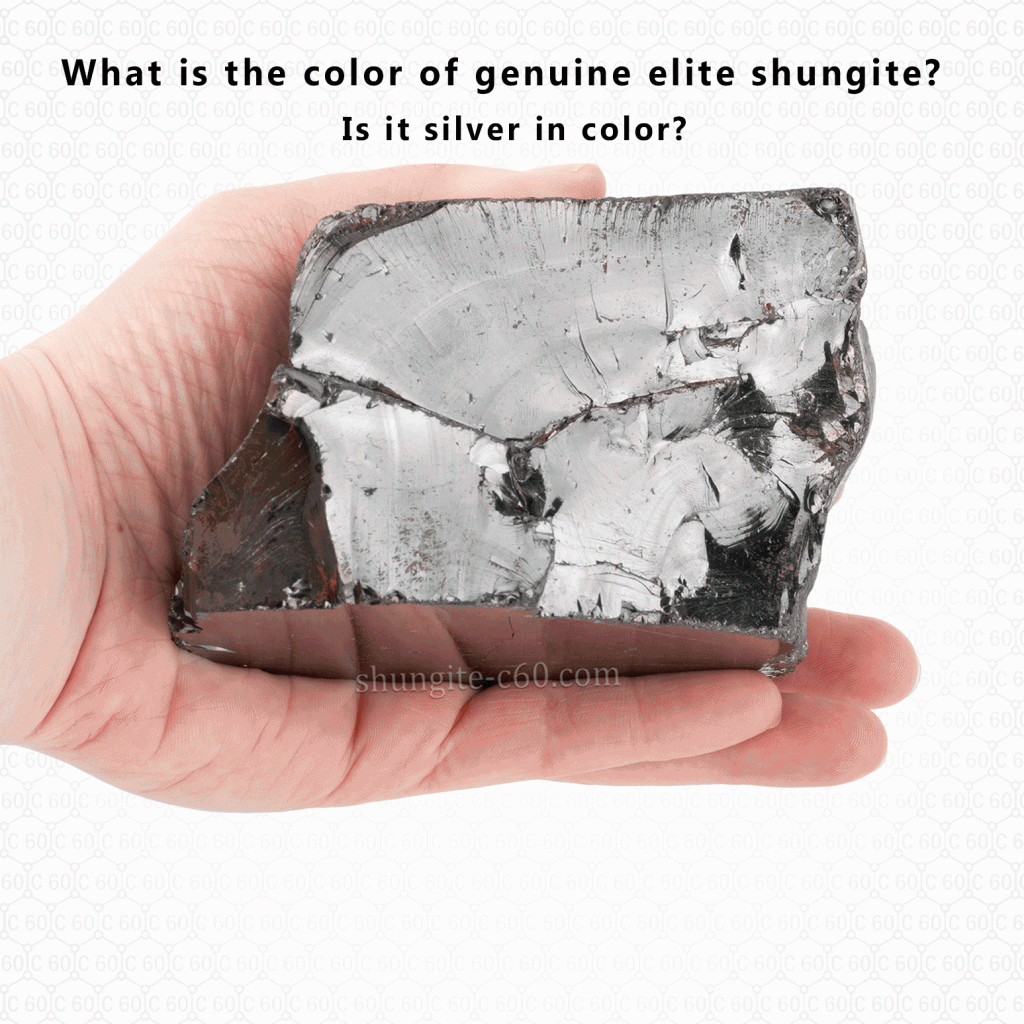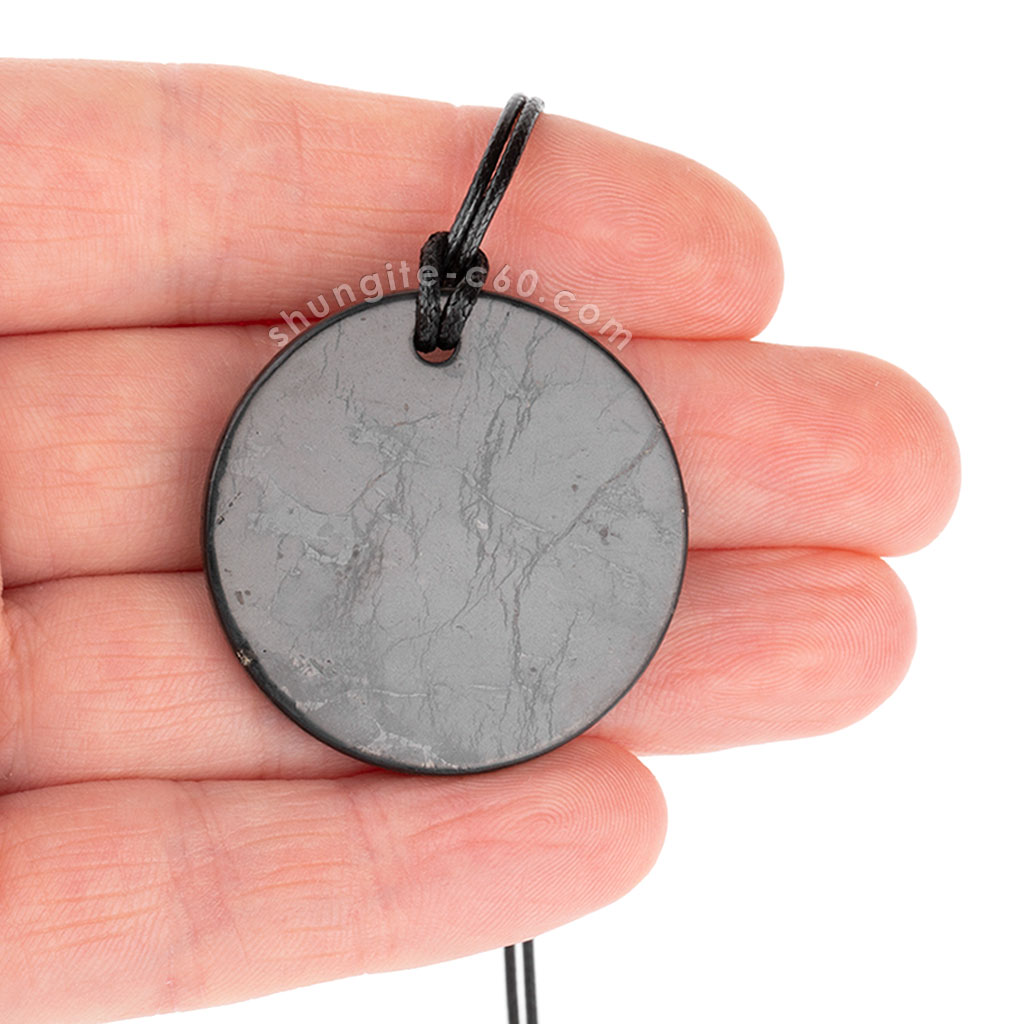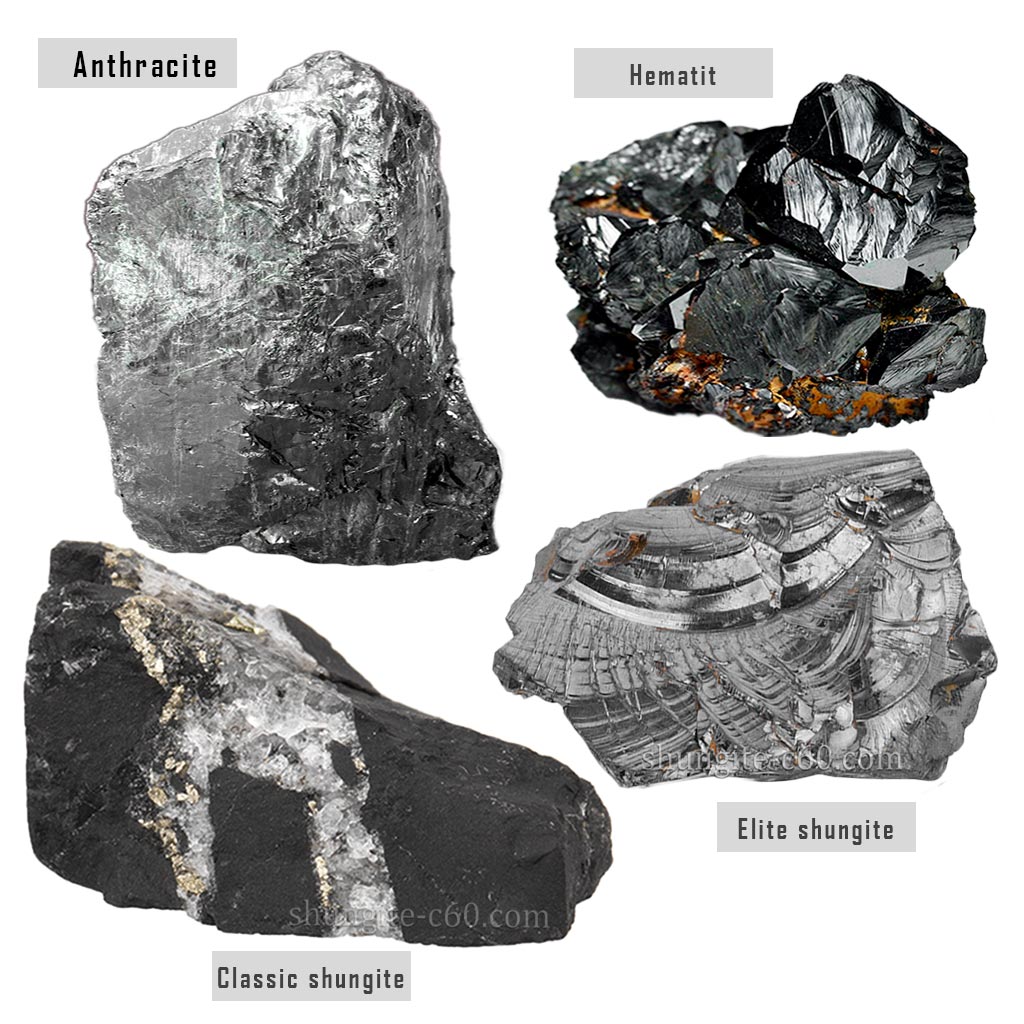Shungite Fake

How do you know if shungite is real?
The easiest and most common way is to check the conductivity. Real shungite stone contains many unique forms of carbon, allowing it to conduct electric current. This method is the easiest at home. But what if other minerals can also conduct electricity? For example, this is a famous rock – Hematite.
Please look at these pictures. Which picture contains of shungite fake?

These are two completely different types of minerals. Likewise, both conduct electricity and are black. The picture on the left is the real shungite, and the image on the right is Hematite.
Russian EMF protection rocks are depicted here as tumbled stones, like Hematite. However, the brilliance of Hematite is more vital than Russian black rock. Both are black, but Hematite conducts electricity because it is essentially iron ore. Russian carbon rocks do not contain metals but conduct current and metal conductors. We study this phenomenon of Karelian black rock a lot.
Brilliant elite silver stone type 1
One of the most common forgeries is the Hematite rock. This silvery rock is very similar in appearance to the Elite Type 1 stones. Above all, these shungite fake rocks and elite stones, type 1 from Russia, can have a gray color and a shiny surface. This is what these hematite samples look like.
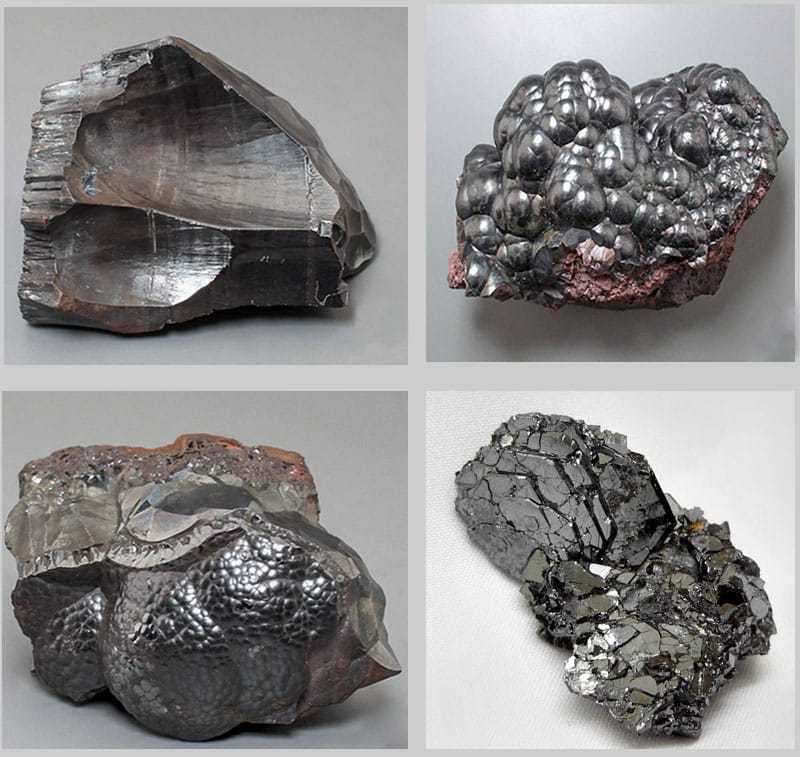
The picture below shows a sample of real shungite stone (Elite) type 1. This is a rare variety of Karelian c60 rocks with the highest carbon content. As you can see, all these patterns are very similar.
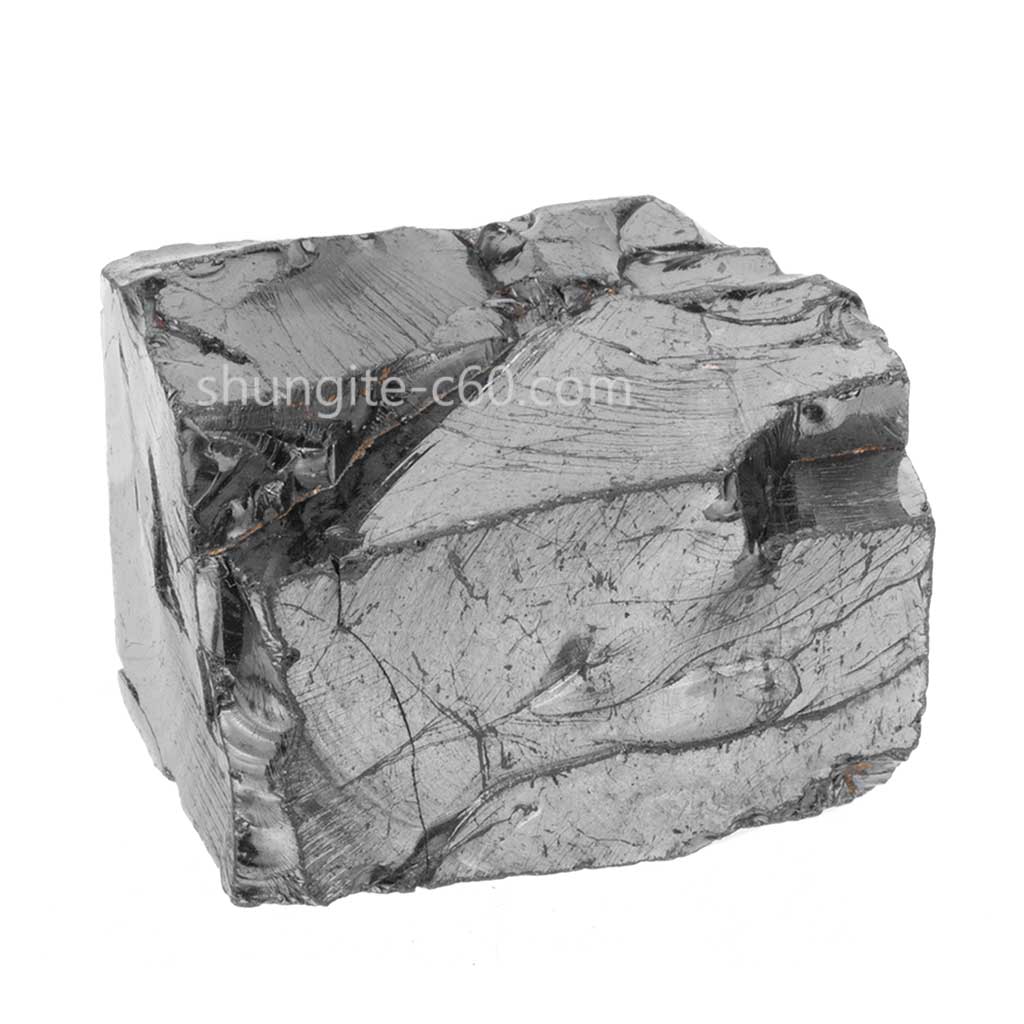
What is Hematite?
Hematite is a black or gray rock. This mineral, as well as Russian rock, has electrical conductivity but a completely different chemical composition. To clarify, 30% of classic black rock consists of a unique form of carbon. Hematite is 70% iron and 30% oxide. Here is its chemical formula: Fe2O3. Hematite is a common iron ore for smelting iron and other industrial applications. Some of the largest and most famous deposits of Hematite are in Ukraine, Brazil, Austria, and other countries.
In addition, there is a vast number of carbon-containing rocks. These rocks are similar to Karelian carbon rocks, but in their chemical composition, there is a minimal amount of unique carbon, or close to zero. For example, it is a field in Kazakhstan. It is worth remembering that authentic Russian real Shungite stones are extracted only in one region on Earth: the Republic of Karelia.
What other ways of checking shungite fake?

Establishing any mineral’s authenticity accurately requires special laboratory conditions and expensive chemical tests. Most people, including intermediaries, do not think and do not suspect fakes. In addition, not all people have the opportunity to use the services of scientific laboratories to study the authenticity of their samples of minerals.
You can view your sample visually. You can’t understand it if you focus only on the photos. Take your sample in your hand. A “classic” real shungite stone is black, similar to coal. Pyrite and Quartz inclusions on its untreated surface are visible and distinguishable.
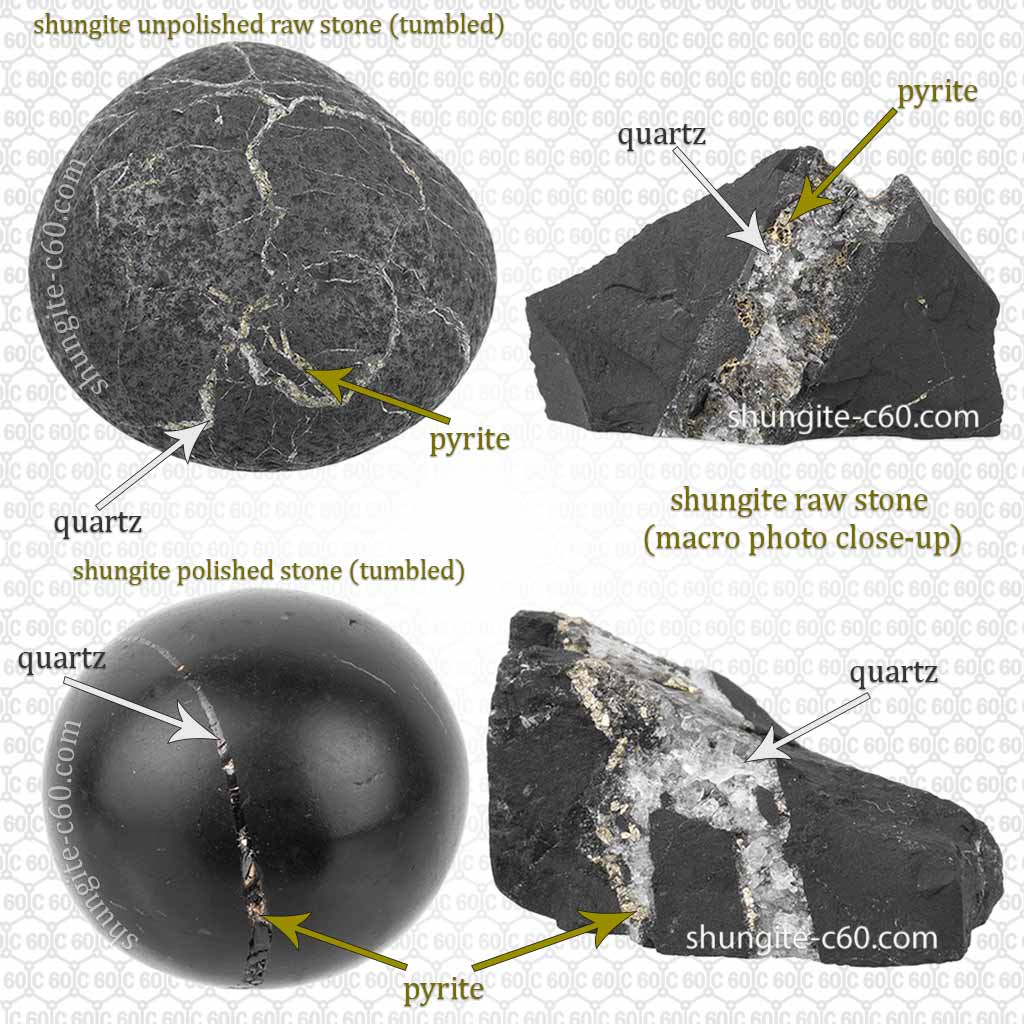
These minerals have a Golden and whitish color. On the polished surface, these inclusions are poorly visible. But they can still be seen if you look at the surface of Russian real shungite stone at a certain angle and lighting. This Untreated mineral can stain your hands, but if it is well-washed in water, it leaves almost no traces.

Elite Silver Rock type 1
Elite Shungite (or noble) rock type 1 has a light gray (but not bright silver) color and smooth surface. It has a homogeneous structure and is nice and soft to the touch. It reflects light and is similar to glass. Some areas are so flat that they look like mirrors. It perfectly conducts electric current.
If you check the conductivity of a particular device, the resistance of the electric current tends to zero. Because it’s almost pure carbon at about 98%, this is a relatively expensive and rare mineral, and the probability of forgery is above.
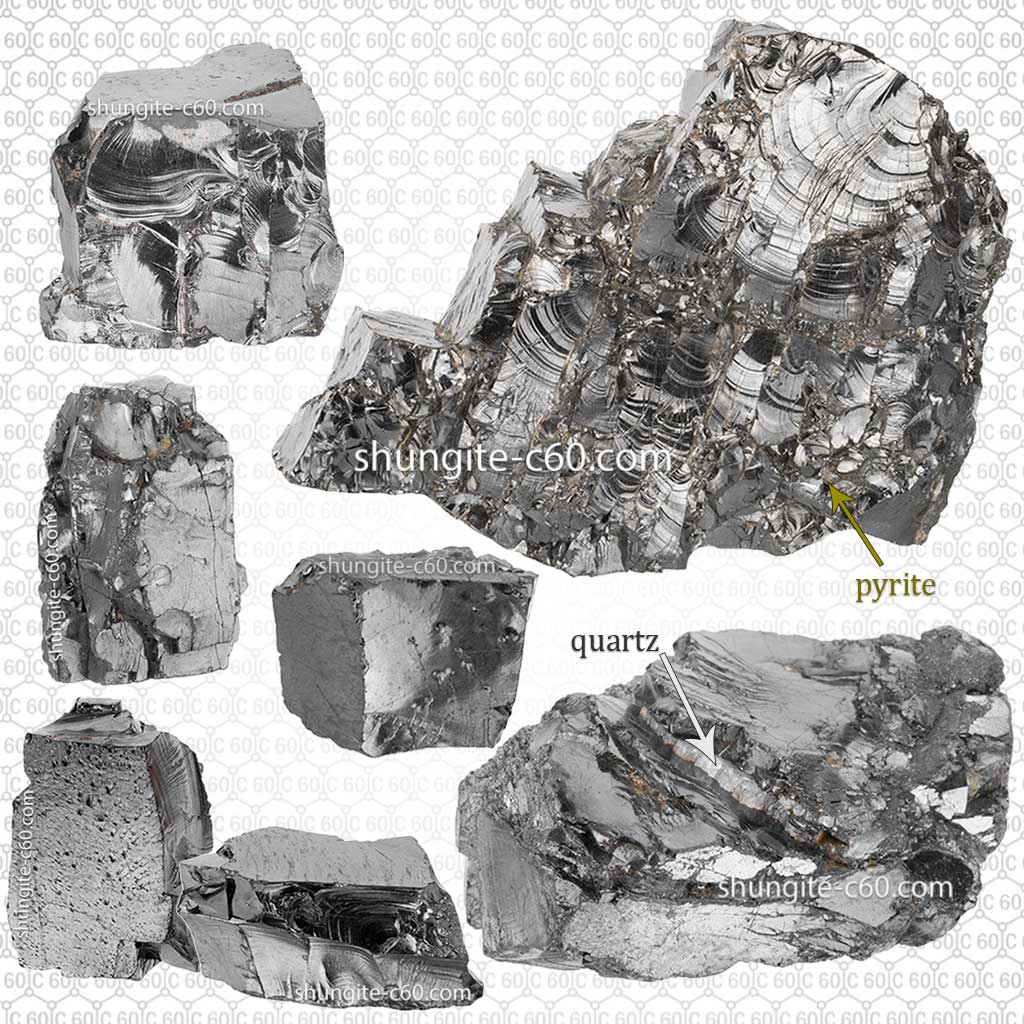
More about the surface of elite 98% carbon Russian mineral
Real shungite stone (elite or noble) has a shiny surface and a diamond-metallic shine in the photo under the number {1}. Very rare nuggets of elite type have two smooth and parallel surfaces with an intense shine — in the photo under the number {2}.
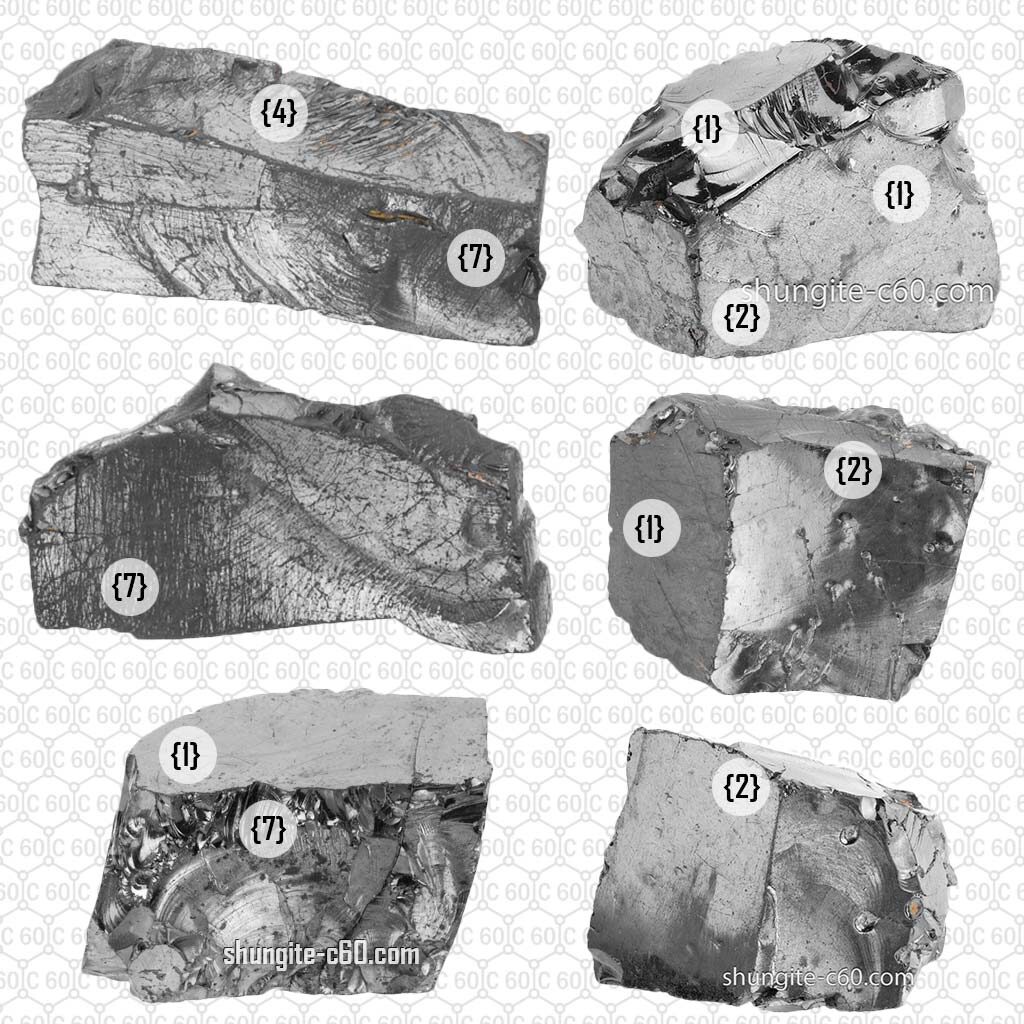
Also, in some places on such surfaces, there are small hills, from which thin cracks radiate out in a ray-like manner — in the photo under the number {3}.
Note that these surfaces have diverging arcuate and fan-shaped cracks in other pieces. In turn, they cross other cracks perpendicularly and in parallel — in the photo under the number {4}.
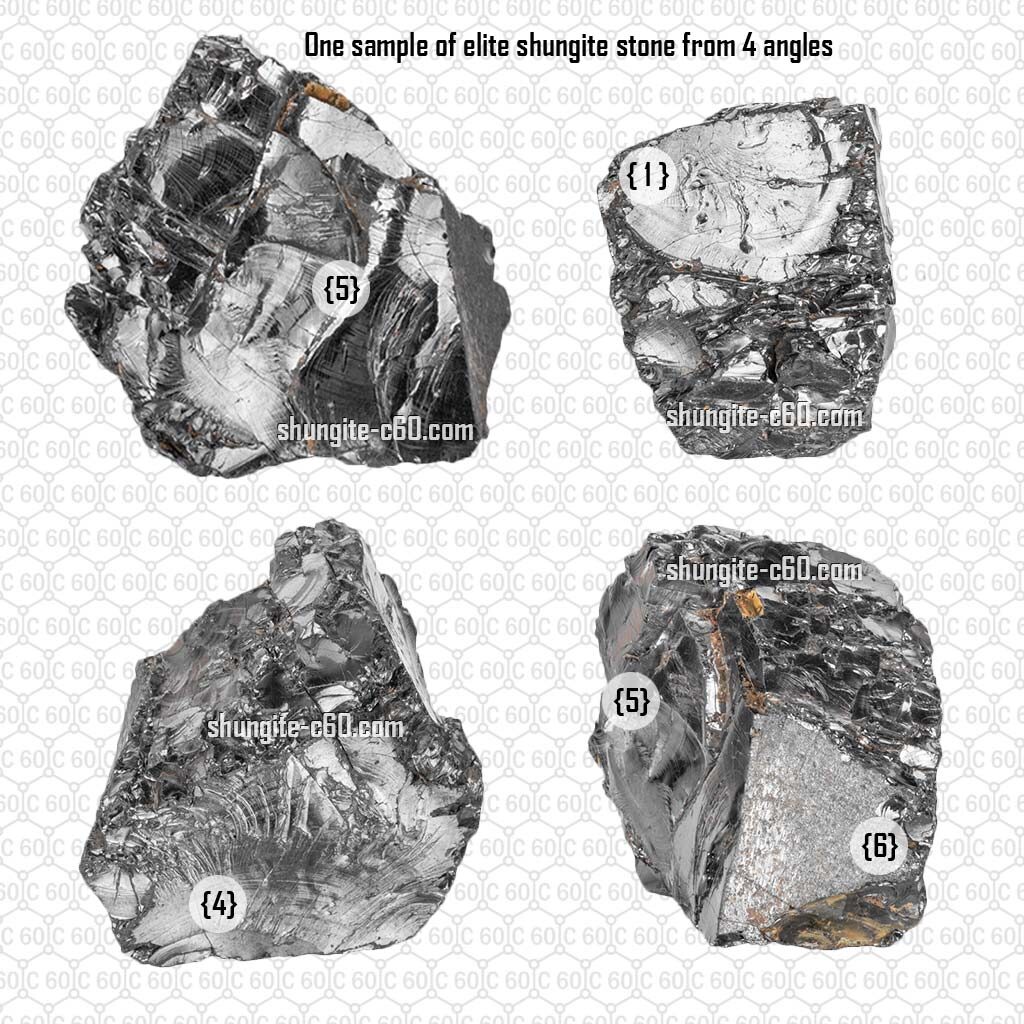
In addition, you may notice that in the same pieces on the surfaces, a slightly wavy surface of the conchoidal fracture is noticeable. For example, the photo will show this under {5}. The rock surface can also be covered with strokes, making it appear matte. For example, this can be seen under {6} in the photo.

Color of streak.
In particular, the mineral’s streak is black with a metallic sheen. You can find out the color of the streak by rubbing the mineral with a more complex sample until a powder appears. You can also rub the mineral with a white porcelain surface, such as the back of your white cup or plate.
Therefore, the color of this powder is the color of the streak. The first photo shows a swatch with the streak color under the number {7}. In conclusion, samples of elite silver minerals have numerous cracks. These cracks can contain oxides of quartz, calcite, and iron.
Shungite Fake: Iron Ore and Magnetite.
Magnetite is a black mineral widely distributed on Earth, a natural iron oxide. Like Hematite, it looks similar to a Karelian elite silver 98% carbon stone. Indeed, this is due to its matching black color, metallic sheen, and conchoidal fracture.

Magnetite conducts an electric current. However, the most significant difference of magnetite is its pronounced magnetic properties, which will be highly magnetized. On the contrary, the Karelian silver mineral is not magnetized. But he conducts electric currents, which consist of a particular allotropic form of carbon.
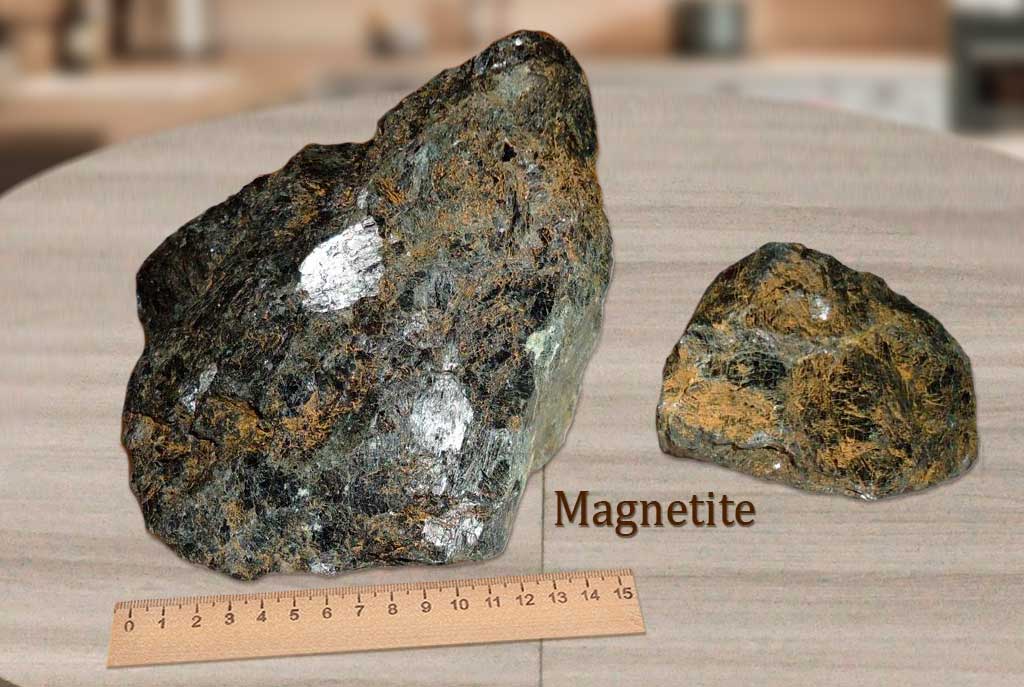
For example, magnetite is mined in Russia in the Kursk magnetic anomaly, in the Middle Urals (the city of Magnitogorsk), and on the Kola Peninsula. It is also found in other countries, such as Azerbaijan, the USA, Canada, South Africa, Norway, etc. At the same time, the only place on Earth with a real shungite stone deposit is the Republic of Karelia (Russia).
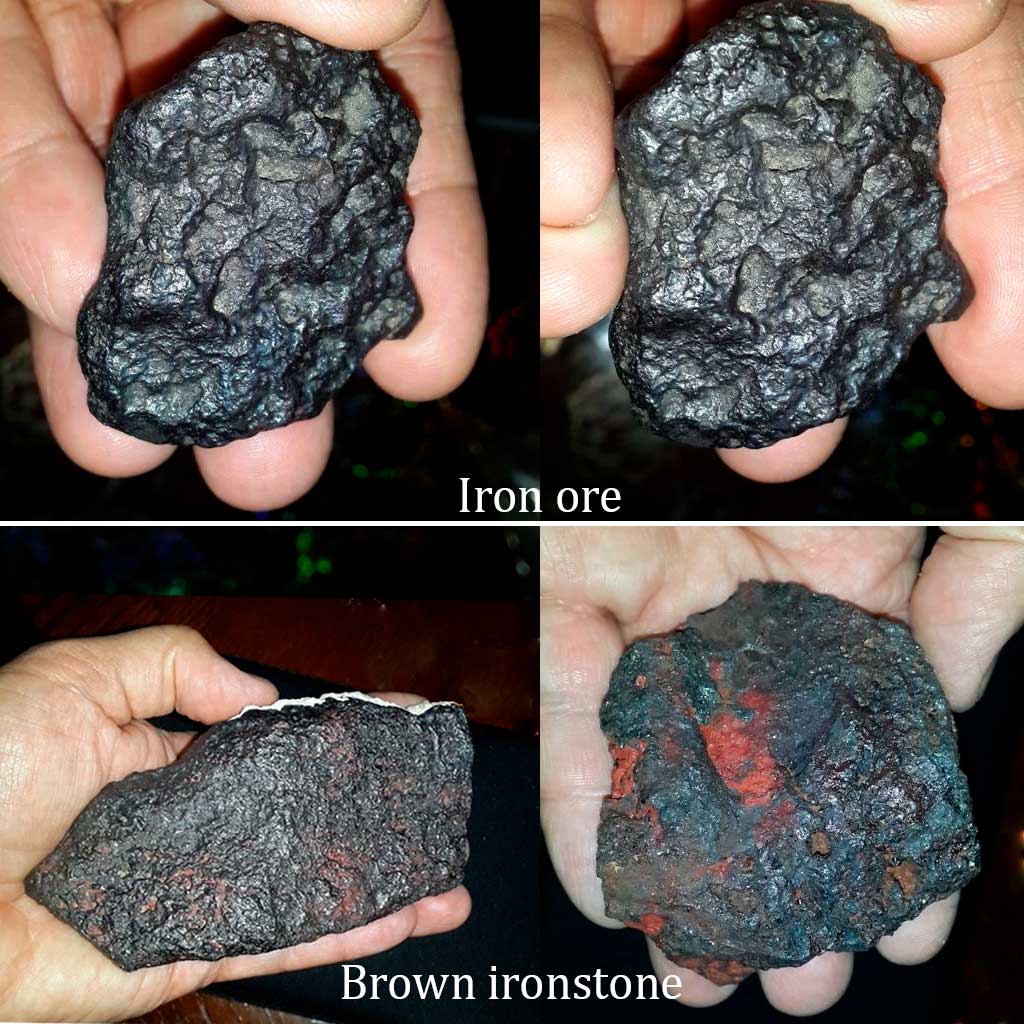
Above all, iron and brown ironstone ore samples may appear the same as in the photo above. And unscrupulous sellers sell iron ore under the guise of elite silver mineral.

Obsidian (volcanic glass).
Likewise, obsidian (volcanic glass), a mineral that looks like an elite Russian silver mineral, is also quite popular. The similarity is based on the minerals’ highly reflective surface and a typical conchoid fracture. However, obsidian has a glass luster, and the noble type 1 mineral has a diamond-metallic solid luster. In addition, obsidian does not conduct electric current.

Shungite Fake from Columbia
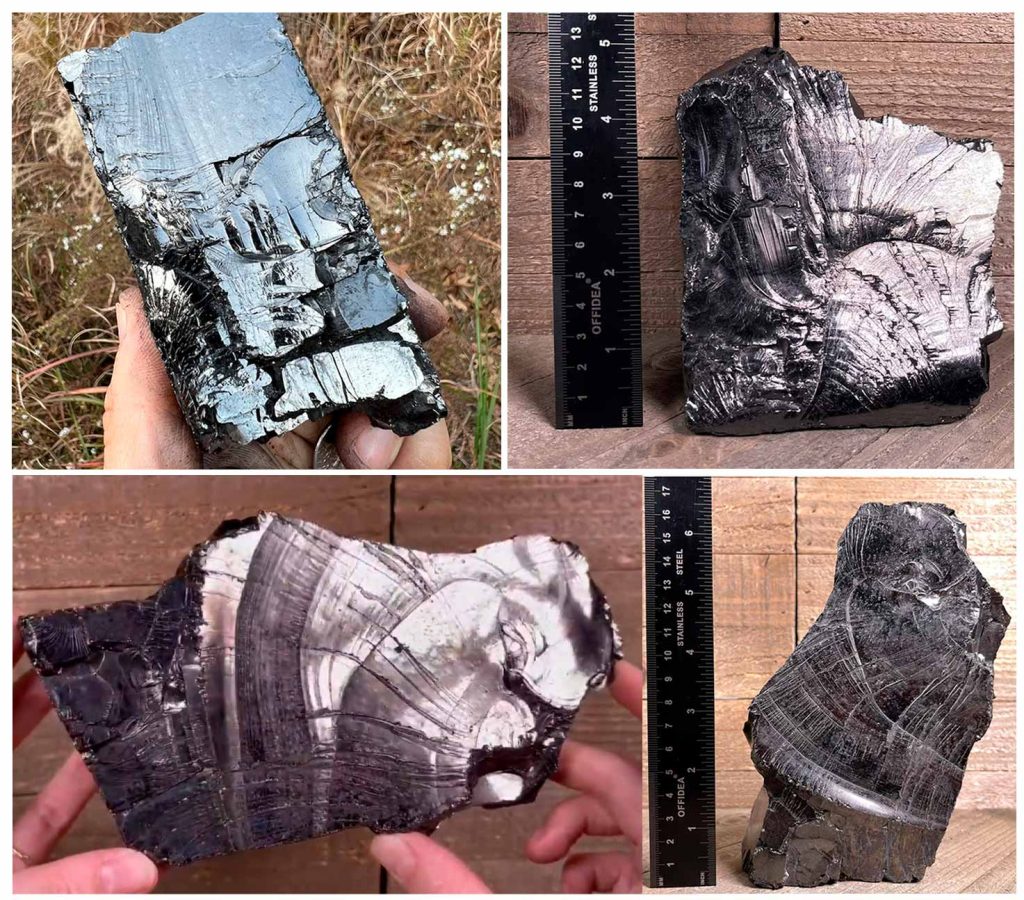
Colombian silver-colored mineral—is it authentic or fake? Our customers informed us that elite Colombian minerals have been sold online since about 2022. Sellers write that the country of origin of these samples is Colombia, South America.
No one has any information about real shungite stone mines in Colombia. If they were there, it would undoubtedly be a big sensation. However, we still tried to find traces of Colombian fake minerals in this extensive research about this fake shungite. In addition, we tried to find rocks in Colombia or nearby that are so similar to Russian rael elite shungite in appearance that they can be easily confused. That’s how we stumbled upon Gilsonite from Colombia and the USA.
However, the very name Colombian mineral or Colombian Elite is a non-existent made-up phrase. The original Elite C60 rock can only be Karelian, the official geological position.
The only place on Earth where genuine elite rocks of the first type with a carbon content of up to 98% and up to 99% and with a content of fullerenes were found is the Republic of Karelia in Russia. Geologists discovered a real shungite stone deposit of the first type in the village of Shunga, so this mineral was called the same name. This is a documented scientific fact and the official name of this Russian mineral.
Silver Fake mineral from Colombia
This so-called Colombian mineral is not a real Russian shungite stone because we do not know its chemical composition and physical properties. Most importantly, this supposedly Colombian rock does not conduct electricity like the original elite Russian mineral.
After all, authentic elite silver rocks from Russia have practically zero resistance to electric current, and therefore, they conduct current almost like metal. Thus, the original elite type 1 Russian mineral has the most important diagnostic feature – electrical conductivity. If you measure the resistance of a sample on a multimeter, then the resistance of real shungite stone (type 1) tends to zero. The resistivity index for elite type 1 mineral is 2,18 ∙ 10-4 Ohm∙m; it is approximately 0,000218 Ohm∙m. Also, this silver Russian rock has a conductivity value equal to 4762 Sim/m.
Measurement of resistance to electric current for real shungite stone (Elite) and fake shungite from Colombia.
In this video, we first measure the current resistance of a metal plug. As we saw, the metal’s resistance to electric current is zero. In the same way, we estimate the resistance to current for a sample of real shungite stone of 1 type, which also has zero resistance to electric current.
Next, we measured the resistance to electric current for a sample purchased from sellers called “elite rock from Colombia;” they also call it Raquerite. As a result of measurements of this sample, we did not see zero, but we saw numbers ranging from 13,8 to 15 and 189, and we also saw even more significant numbers of resistance.
What resistance to electric current does a sample of fake shungite have?
These figures do not mean that the sample resistance is 15 ohms. After all, we measured the resistance in the sensitivity range of 200K, so the multimeter switch was set to 200K. The letter K means, in the SI system, the range of values 103 or 1000 Ohm.
Thus, to understand the resistance of this sample of the supposedly “gray color stone from Colombia,” we need to multiply the number 15 by 200 and by 1000: 15*200,000 = 3,000,000 ohms. This is the minimum value that we took for a visual calculation.
So, we have seen that this sample of so-called “elite pebble from Colombia” has a resistance to electric current of at least 3 million ohms, while for real shungite stone, this figure is 0. This means that this sample has nothing to do with Real Russian C60 rock; it can be anything—anthracite or a solid hydrocarbon—but not Russian stone.
The main diagnostic characteristic of real shungite stone is electrical conductivity.
Moreover, even a black variety of real shungite stones of the third type with a carbon content of about 30% also conducts electricity well, like the elite silver mineral of the first type. In connection with this quality, scientists realized that real Russian C60 rock can protect against the effects of dangerous high-frequency waves.
But this sample of allegedly color rock from Colombia, which supposedly has up to 99% carbon (not confirmed), fails to have the same high electrical conductivity. It is also resistant to current, millions of times greater than real shungite stone.
We will make all measurements on the multimeter publicly available and calculate other physical and chemical characteristics of this sample of supposedly Colombian rock. However, a conductivity test is sufficient to verify the authenticity of the sample. We are driven by curiosity so that we will conduct all available experiments.
Allegedly, elite shungite from Colombia has a faint luster.
For example, in this photo, we photographed a sample of real elite silver Russian mineral and a sample of fake shungite called Colombian. This photo was taken in low natural light.
Here, you can see that one sample reflects light so much that it even looks white because of a flare. This is how a smaller original sample of elite minerals shines. This specimen also has an orange pyrite coating on its surface.
But next to it on the right is a sample with a dimmer shine and a brown tint. This shade is not typical for authentic, real, elite minerals. Perhaps this brown shade tells us we have some asphalten of a young age or anthracite.

The so-called elite mineral from Colombia is more fragile and lighter than the real shungite stone (Elite).
A sample of the so-called silver mineral from Colombia was more fragile than the elite Russian stone, and it crumbled quickly.
Another critical moment was when we held this sample of supposedly Colombian rock in our hands and realized it was much lighter than samples of elite type 1 of the same volume. This suggests that the specific gravity of this fake shungite is less than that of the real one.
This fact corresponds to our measurements; the specific gravity of this fake elite Colombian rock sample was approximately 1.44 gr/cm3. This figure is less and does not fall within the real shungite stone, which has a specific gravity of 1.7-2 gr/cm3.
Thus, a sample of the so-called Colombia rock does not conduct current like the original Russian rock; it does not shine brightly and is more fragile and lighter than authentic elite Karelian silver mineral.
Therefore, even without the results of a chemical study of this sample, it is already clear that these are entirely different objects. This fake from Colombia is not a real Russian mineral Elite type 1.
The so-called elite mineral from Colombia has all the features of anthracite.
Judging by the indicators of very low electrical conductivity and light-specific gravity, this fake from Colombia is anthracite.
This is true, because anthracite is not uncommon in the mid-east of the United States, we are talking about Pennsylvania. Moreover, in Colombia, there are anthracite mines, such as Santander. All this anthracite coal looks very similar to real shungite stone, 98% carbon. For example, you can find on forums discussing the findings of a shiny rock, in which American residents of the US coal region immediately recognize anthracite.
Shungite Fake: Anthracite
We were asked about a strange product with a ribbed surface in the photos. This is anthracite, a silver-colored mineral widely used as a fake of shungite. The differences are very clearly visible in these photographs.
The danger is that anthracite conducts electricity but does so rather weakly. Its conductivity is much worse than that of real c60 rocks from Russia.

Also, this anthracite has a finely ribbed, layered, including a multidirectional structure of thin layers that were once superimposed on each other and then petrified. Anthracite is a sedimentary rock; it is the most ancient coal.
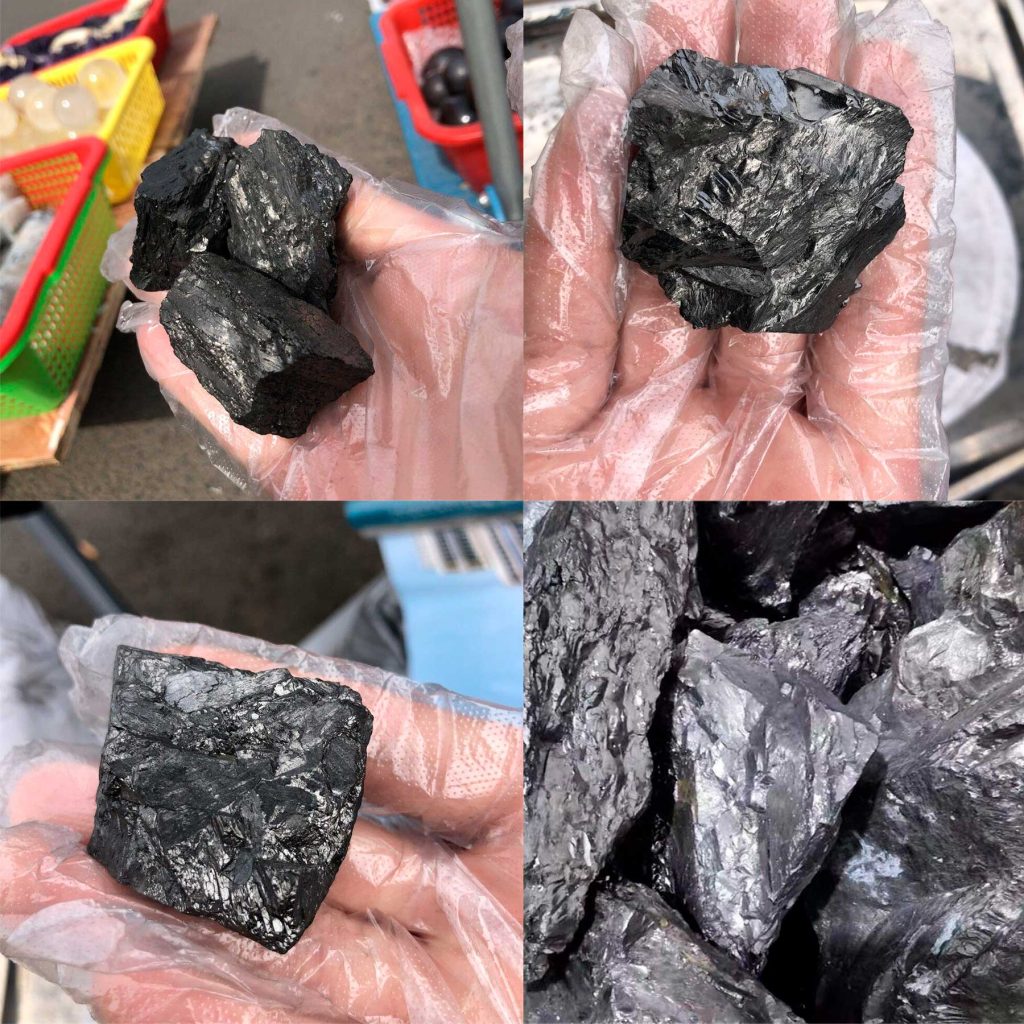
This anthracite has a finely ribbed, layered, including a multidirectional structure of thin layers that were once superimposed on each other and then petrified. Anthracite is a sedimentary rock; it is the most ancient coal.
Also, Elite Russian mineral type 1 does not have such a structure. In the process of formation, the real shungite stone type 1 resembled a liquid gel-like structure, which filled the cracks in the C60 rocks in Karelia. Elite silver rock type 1 is not sedimentary; it is a special, rare mineral.
Also, pay attention to the brilliance. The brilliance of elite mineral type 1 from Russia is intense; geologists call it diamond brilliance. Anthracite has a slightly different luster; it is weaker and semi-metallic. In addition, these samples even have some oily luster.
Terahertz Stone
Recently, you can often notice unscrupulous sellers, mainly from India and China, who pass off some mysterious terahertz stone as elite shungite. They offer fake supposedly native crystals or cabochons, similar to a rare mineral from Russia.

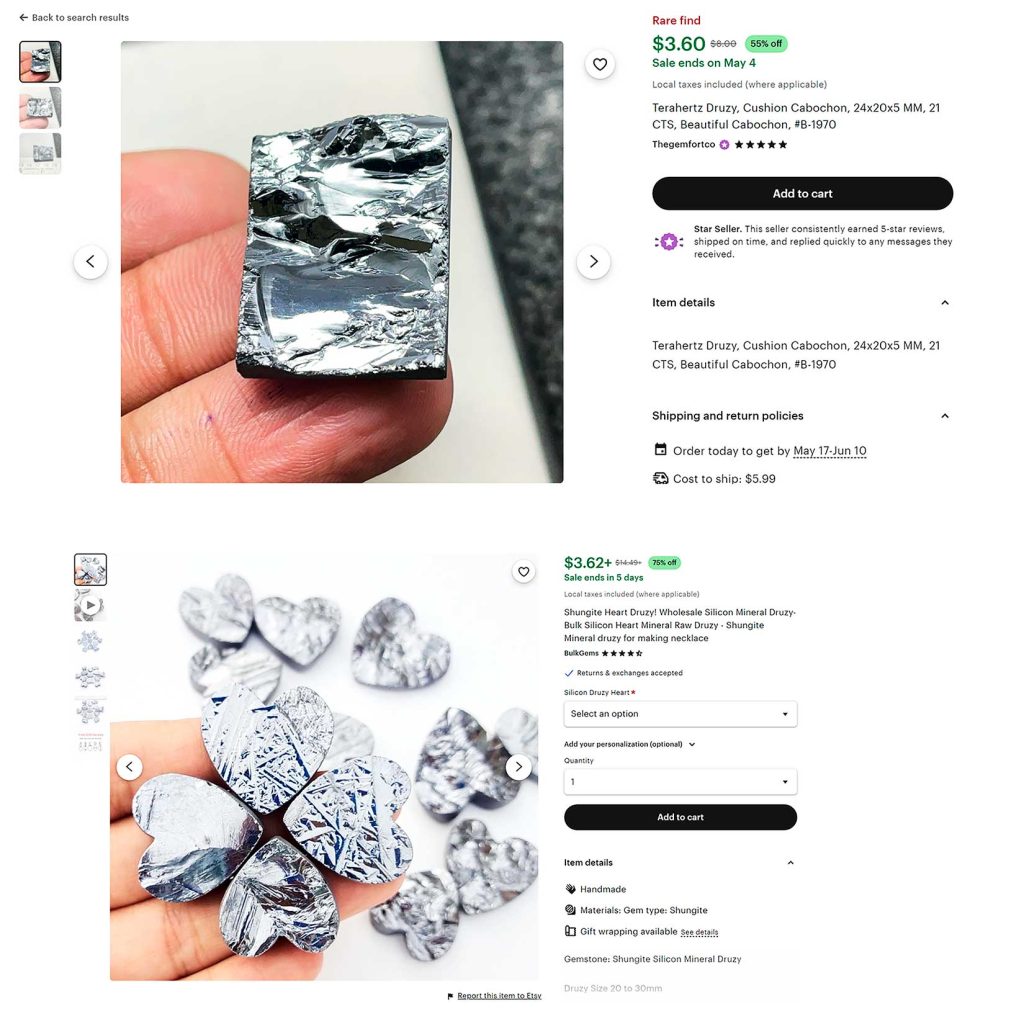
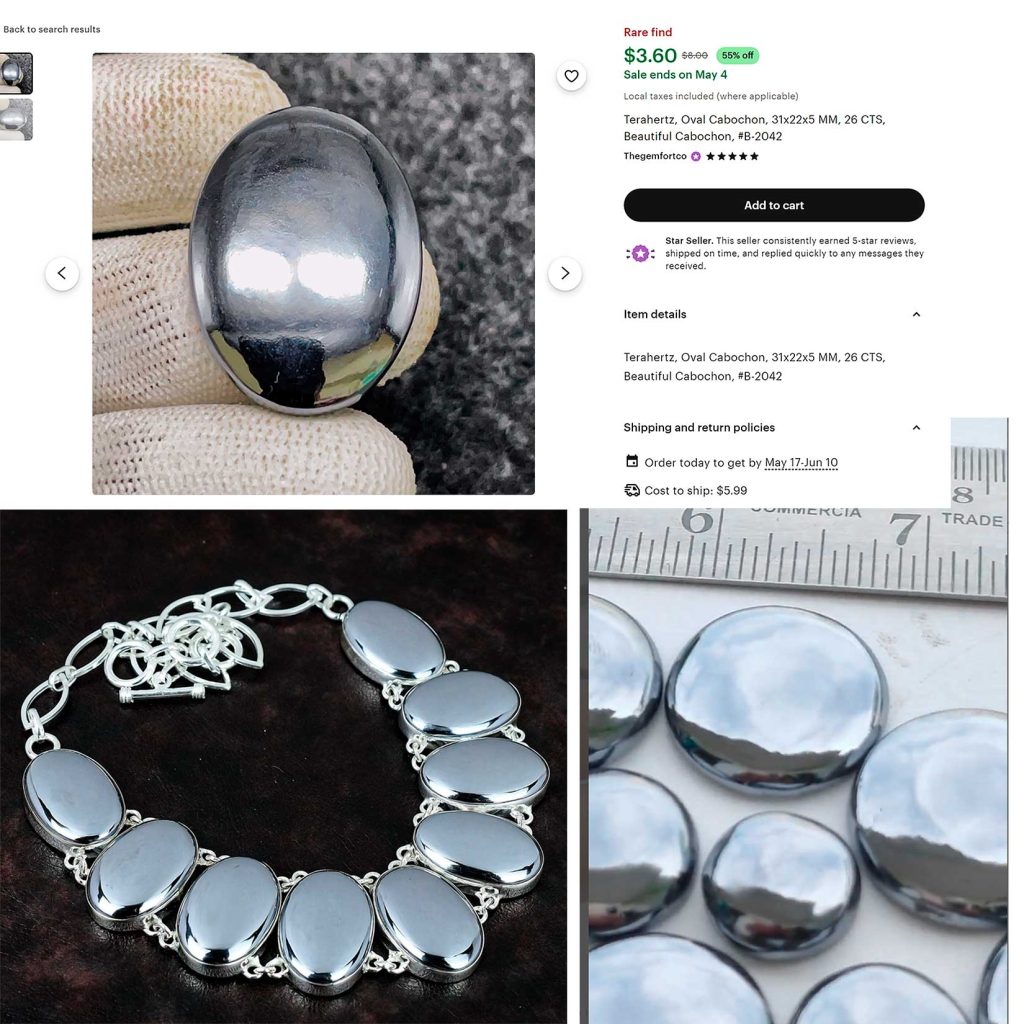
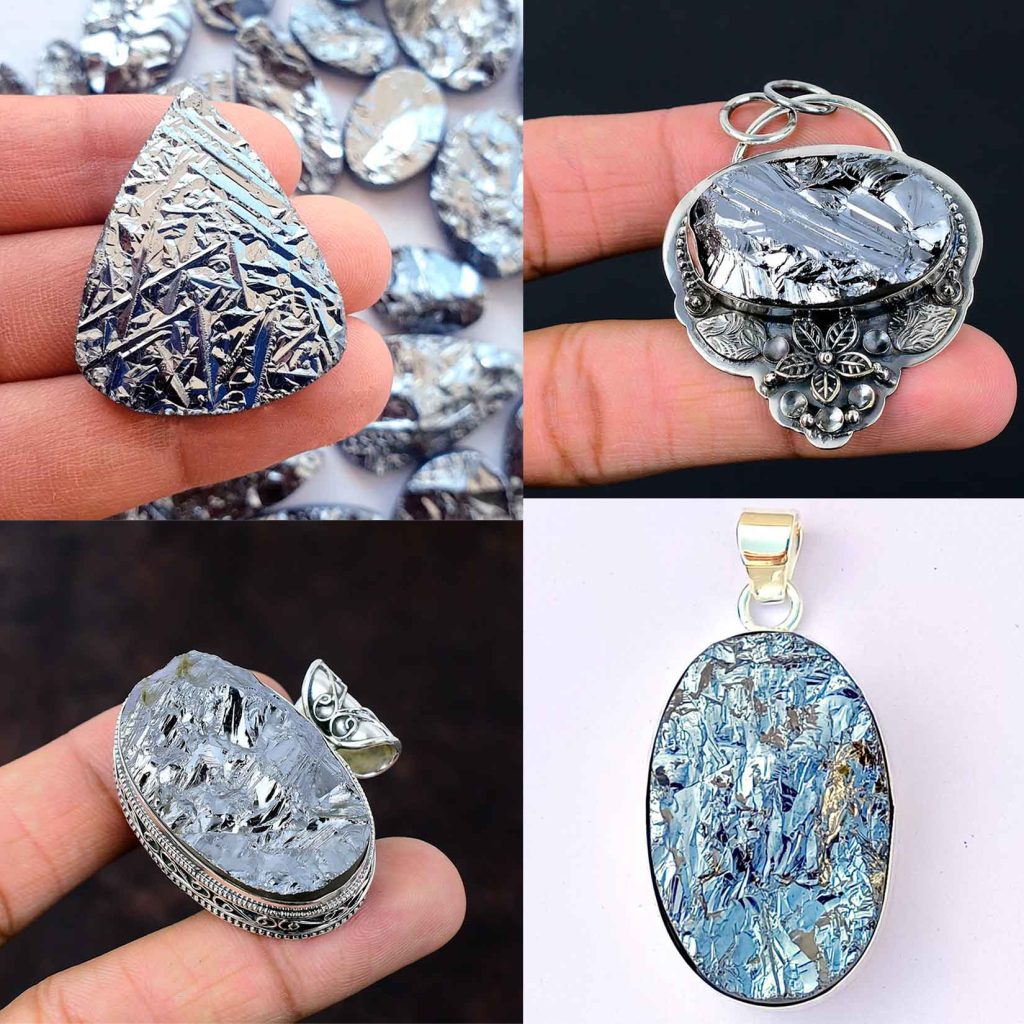
Of course, this is another fake, from which they can also make pendants, bracelets or plated smooth pieces. They are often passed off as a healing mineral or sold under names that contain words and combinations of them:
- Silicon Elite Shungite Druzy
- Terahertz Stone Cabochon
- Wholesale Silicon Mineral Druzy
What is Terahertz?
Terahertz is a by-product that is obtained as a result of growing artificial silicon single crystals for electronics. These crystals are grown in a special way so that they have the specified parameters. However, often in production monocrystalline silicon may have growth defects and the crystals turn out to be defective.
Thus, the so-called terahertz is simply waste from electronics production, a defective crystal of monocrystalline silicon. It is not a mineral or a stone.
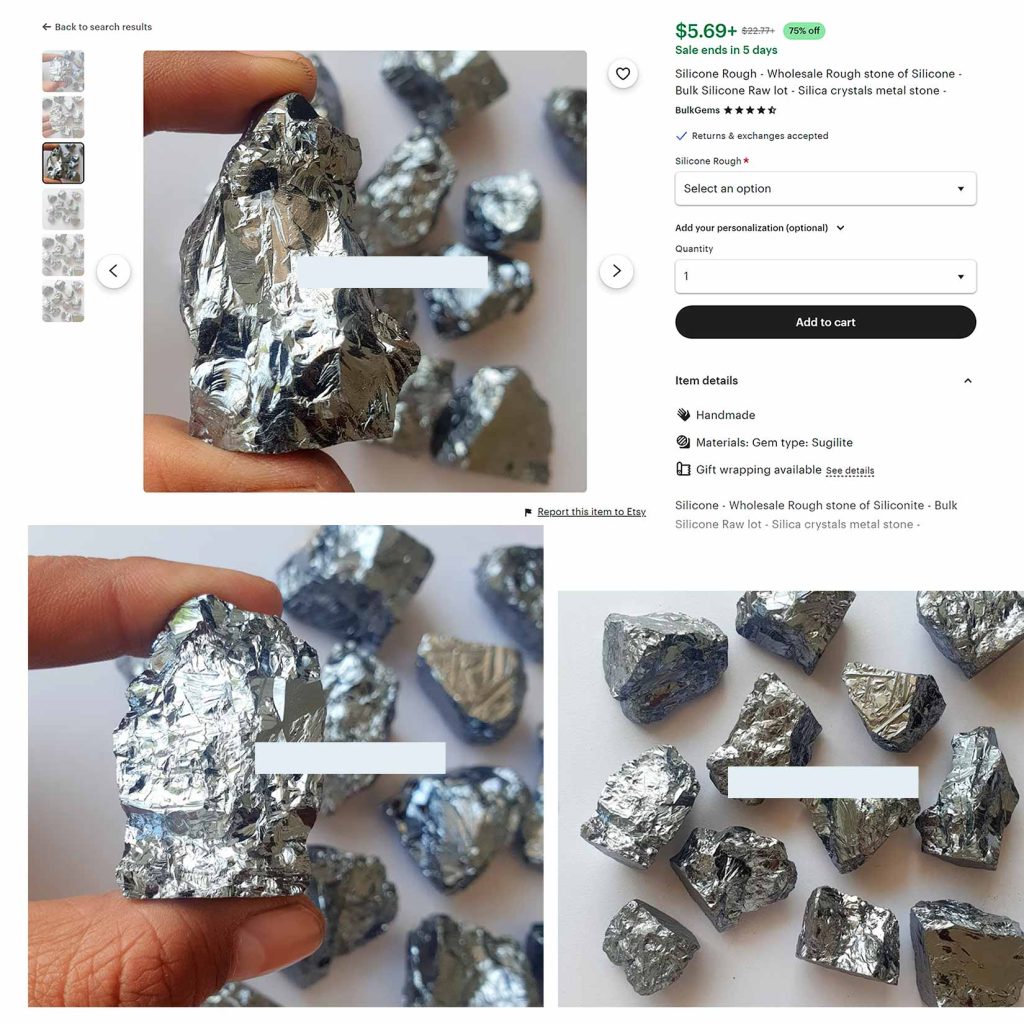

Why is this counterfeit mineral dangerous?
Indeed, elemental silicon does not exist in nature, so silicon is grown from a gas environment for the production of electronics and chips. This gaseous environment is created in special chambers, and the silicon production waste from these chambers contains various chemical components of these refractory crucibles. For example, this silicon production waste contains a chemical element such as TITANIUM. At the same time, Titanium contained in terahertz stone negatively affects the human and animal body; it can cause fatigue, headaches, swelling, breathing problems and other illnesses.
What do Terahertz and elite shungite have in common?
There is nothing in common between “Terahertz stone” and elite shungite. If elite shungite is an ancient rare mineral, then terahertz is not a mineral or a stone, but artificial silicon is a waste of the electronics industry. Also, this artificial silicon is very light and brittle and it contains large amounts of the dangerous chemical element titanium.
However, they also have some external similarity, as they are silver in color. In addition, monocrystalline silicon (Terahertz) is a conductor of current, just like the elite shungite mineral. Therefore, this allows scammers to pass off this fake as a rare mineral from Russia.
Shungite fake: Why can you trust us?
Above all, we are not intermediaries and are located directly in Karelia. You will receive real shungite stone from its field from us now. Therefore, this eliminates the risk of getting a fake shungite from intermediaries from other countries or regions of Russia, where there are many similar rocks. They look like real Russian rock only in appearance. They can be black or shiny, like anthracite or asphaltene.
We make all our products only from 100% real shungite stone. We control the entire production process, from the supply of raw stone to the final product.
In addition, we cooperate with one of the largest companies to protect transactions on the Internet. Above all, this is a PayPal company, and every transaction on our website is protected.
Please remember that not all gold that glitters. Most importantly, other carbon-containing rocks or Hematites (often given for genuine, but it is a shungite fake) are cheap but do not have unique abilities, are useless for health, and are used only in the industry. Such products can be found in the USA, Ukraine, Poland, Russia, China, etc.
 Dutch
Dutch English
English French
French German
German Italian
Italian Spanish
Spanish Swedish
Swedish